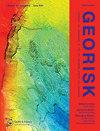Experimental modelling of spudcan penetration in spatially variable soils
IF 4.8
3区 工程技术
Q1 ENGINEERING, GEOLOGICAL
Georisk-Assessment and Management of Risk for Engineered Systems and Geohazards
Pub Date : 2023-06-21
DOI:10.1080/17499518.2023.2222366
引用次数: 0
Abstract
ABSTRACT The influence of spatial variability of soils on spudcan penetration responses is found significant through numerical methods. However, due to the difficulty of preparing spatially variable soils, the penetration mechanism of the spudcan through random soils remains physically unclear. Therefore, this study aims to investigate the effects of the spatial variability of soils on the penetration behaviour of spudcan foundations by laboratory tests. A new method to prepare the spatially variable soils was proposed first. Then, three physical soil models with different scales of fluctuation and coefficients of variation were carefully prepared. The spudcan penetration was conducted in these three soil models and the penetration mechanism of the spudcan was investigated. The penetration resistances of the three cases were obtained and compared with that predicted by the methods suggested by ISO and SNAME standards. The results show that the predicted error of the penetration resistance can reach 50% when the soils have a large coefficient of variation and a small horizontal scale of fluctuation. The large difference is the significant spatial variability that has been ignored in the standards. This study paves the way to an accurate prediction of the spudcan penetration analysis in strong variable soil seabed.空间变化土壤中钻柱穿透的实验模型
本文章由计算机程序翻译,如有差异,请以英文原文为准。
求助全文
约1分钟内获得全文
求助全文
来源期刊
CiteScore
8.70
自引率
10.40%
发文量
31
期刊介绍:
Georisk covers many diversified but interlinked areas of active research and practice, such as geohazards (earthquakes, landslides, avalanches, rockfalls, tsunamis, etc.), safety of engineered systems (dams, buildings, offshore structures, lifelines, etc.), environmental risk, seismic risk, reliability-based design and code calibration, geostatistics, decision analyses, structural reliability, maintenance and life cycle performance, risk and vulnerability, hazard mapping, loss assessment (economic, social, environmental, etc.), GIS databases, remote sensing, and many other related disciplines. The underlying theme is that uncertainties associated with geomaterials (soils, rocks), geologic processes, and possible subsequent treatments, are usually large and complex and these uncertainties play an indispensable role in the risk assessment and management of engineered and natural systems. Significant theoretical and practical challenges remain on quantifying these uncertainties and developing defensible risk management methodologies that are acceptable to decision makers and stakeholders. Many opportunities to leverage on the rapid advancement in Bayesian analysis, machine learning, artificial intelligence, and other data-driven methods also exist, which can greatly enhance our decision-making abilities. The basic goal of this international peer-reviewed journal is to provide a multi-disciplinary scientific forum for cross fertilization of ideas between interested parties working on various aspects of georisk to advance the state-of-the-art and the state-of-the-practice.

 求助内容:
求助内容: 应助结果提醒方式:
应助结果提醒方式:


